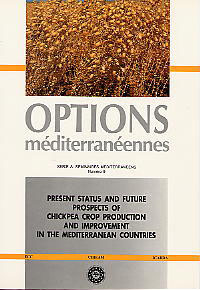| Article précédent | p. 157-161 | Article suivant |
Chickpea breeding in Spain
Chickpea breeding began in Madrid almost thirty years ago and then continued in Córdoba (Andalucía). Studies on quantitative genetics, including yield and seed quality components, as well as others aimed at the evolution of Cicer arietinum as a cultivated species have been performed. Four cultivars have been registered, two of them derived from Spanish landraces, the other two being reselections of two ICARDA lines. New cultivars derived from crosses between Spanish, ICARDA and ICRISAT lines are currently being obtained. Wilt, root-rot and virus attacks seem to be their most important constraints from a biological point of view. However, the most important factors explaining the decrease in chickpea cultivated area are non-biological ones such as importation of chickpea from Mexico, migration of rural population to urban areas etc. The use of chickpea for animal feeding would allow for an increase in the cultivated area.
- [ Afficher ]
- [ Télécharger ]
- [ Exporter la citation ]
Vous pouvez télécharger la citation au format :
- [ Imprimer ]
-
Mots-clés
AMELIORATION DES PLANTES, CICER ARIETINUM, ESPAGNE, GENETIQUE, SEMENCE, VARIETECiter cet article
Cubero J.I., Gil J., Moreno M.T. Chickpea breeding in Spain. In : Saxena M.C. (ed.), Cubero J.I. (ed.), Wery J. (ed.). Present status and future prospects of chickpea crop production and improvement in the Mediterranean countries. Zaragoza : CIHEAM, 1990. p. 157-161. (Options Méditerranéennes : Série A. Séminaires Méditerranéens; n. 9). Present Status and Future Prospects of Chickpea Crop Production and Improvement in the Mediterranean Countries, 11-13 Jul 1988, Zaragoza (Spain). http://om.ciheam.org/om/pdf/a09/91605025.pdf



